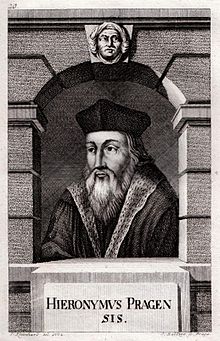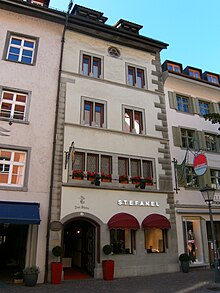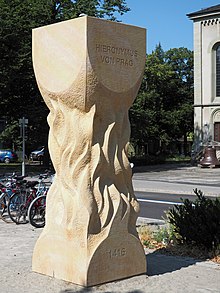Jerome of Prague
Hieronymus von Prag (* around 1379 in Prague ; † May 30, 1416 in Constance , Czech: Jeroným Pražský) was a Bohemian scholar, a fellow campaigner of Jan Hus and co-founder of the Hussite movement.
Traveling Scholar
Kuttenberg decree
Jerome of Prague studied in Prague and acquired in 1398 at the Charles University in Prague the bachelor -degree. He was a philosopher and not a theologian. In 1399 he traveled to Oxford, familiarized himself with Wyclif's teachings, copied his books and spread them in Bohemia. In 1403 he traveled as far as Jerusalem. Between 1404 and 1405 he was in Paris, studied and acquired the degree magister in artibus and worked as magister regens . In 1406 he was a magister artium at the University of Cologne and Heidelberg. After that, he received his master's degree from the University of Prague. He was a supporter of John Wyclif and was involved in the Kuttenberg Decree of 1409, which gave the Bohemians a majority of the votes for the first time in decisions by the University of Prague. Foreign scholars and German students then left the university. In 1410 he traveled to Buda and Vienna.
Vienna trial
In Vienna he was charged with disseminating the ideas of John Wyclif, who spoke out against the wealth of the Church and the hierarchies. He promised not to leave Vienna before the end of the proceedings, otherwise he would be excommunicated and found guilty of perjury. He fled secretly. After the request on September 20, 1410 at the church door of St. Stephen to appear personally for the trial, on October 22, 1410 he was found guilty of perjury and excommunicated for not appearing. On August 31, 1412 he was summoned again, did not appear again and was sentenced as a heretic.
Conversations with Orthodox clergy
In 1413 he traveled to Krakow and from there to Lithuania within the Kingdom of Poland-Lithuania and to the cities of Vitebsk, Pskow and Vilna. He sought contact with representatives of the Orthodox Church .
Think tank
Jerome of Prague criticized the Church in practice. Poggius Florentinus described Hieronymus of Prague as a person with great knowledge, great eloquence, excellent memory, quick-wittedness and fearlessness. In some views Jerome of Prague was more radical than Jan Hus himself. It was a major concern of his to carry out a possible church reform on the basis of the original tradition. He was a late medieval thinker and writer of philosophical writings.
End by the Council of Constance
Way to Constance
When Jan Hus was arrested at the Council of Constance , Hieronymus hurried to Constance in the spring of 1415 to defend him. On April 4, 1415, he and his students arrived in Konstanz unrecognized and lived in the Zum Delphin house at Hussenstrasse 14. He was warned by the Bohemians in Konstanz and withdrew to Überlingen . From there he applied to the council on April 7, 1415 for safe conduct. When he learned that he was about to be arrested, he made his way back to Prague. After spending the night in Hirschau in the Upper Palatinate, he was arrested on the way back on April 24, 1415 on the basis of tips from the local bailiff Teynstauffer and brought to the Count Palatine Johann in Sulzbach-Rosenberg in the Upper Palatinate and put in shackles. Count Palatine Johann reported to the council. This demanded extradition due to an already existing summons for heresy on April 18, 1415. Jerome of Prague was placed in iron chains and transferred by the Count Palatine to Constance and arrived there on an open carriage with a long chain on May 23, 1415.
Interrogation and incarceration
He was interrogated in the Franciscan monastery and imprisoned in the dungeon in the tower near St. Paul at Oberen Laube 73 in Constance. Jan Hus was burned on July 6, 1415. Given the certainty that he would also end up at the stake , Jerome of Prague contradicted the 45 theses of John Wycliff and the 30 articles of Jan Hus on September 23, 1415 before the council. But he continued to be incarcerated. The procedure was restarted. He was incarcerated in the tower for a year minus seven days. He could not read or see anything there and complained about the inhumanity towards him, the harshness and the stench.
Confession and Church Condemnation
Jerome of Prague gave his defense speech and distanced himself from his revocation on May 23 and 26, 1416 in the cathedral. He professed the teachings of Wycliff and Jan Hus and castigated the abuse, arrogance, luxury and pomp of the prelates. The property of the church is to be used first for the poor and pilgrims and only then by the church. On May 30, 1416 he was condemned as a heretic by the council in Münster. The heretics hat sat Jerome of Prague itself and pointed out that Christ bore the crown of thorns.
Secular execution
He was handed over to secular power and burned in the same place as Jan Hus in Constance. The noble Stockach nobleman Eberhard IV von Nellenburg (1363–1422) led Jerome of Prague with other nobles to his execution and supervised them. Jerome of Prague died in agony.
His bed, clothes, and belongings were also burned at the stake. The ashes were shoveled into a cart and thrown into the Rhine.
Poggio Bracciolini reported on this event in a letter to Leonardo Bruni .
“… When he got to the place where he was to die, he took off his clothes himself, fell on his knees, and praised and honored the stake to which he was to be bound and to die. First he was tied naked to the post with wet ropes and a chain, and then large logs were stacked around his chest with chaff placed between them. When the fire was lit, he began to sing praise and the creed: Credo in unum deum - I believe in the one God. The smoke and the fire absorbed and dimmed the last. ... "
Confusion with rotten fish
For centuries Hieronymus of Prague was nicknamed "Lazy Fish" in literature. According to research, the reason for this is that his person was mistaken for the master of arts Nicolaus Faulfisch, who was older and never at Lake Constance.
Commemoration
A commemorative plaque on the Zum Delphin house at Hussenstrasse 14 in the old town of Konstanz reminds us that Hieronymus of Prague lived here in 1415 before he fled. ( Location ). The connecting lane between Hussenstrasse and Laube, in which the St. Paul's Church was previously located, was called Hieronymusgasse from 1876 to 1939. It was renamed Pfauengasse during the National Socialist era. It wasn't until 2003 that it was given the original name Hieronymusgasse again. On the upper arbor 73, where Jerome was imprisoned in chains in the tower near the Paulskirche, a plaque commemorates Jerome of Prague since 1867. The “Flaming Chalice” monument to Jan Hus and his colleague Hieronymus von Prag is located in the arbor, at the height of the Luther Church. ( Location ). In the Paradise district is the Hussenstein , where Jan Hus and later Hieronymus of Prague were burned. ( Location ).
His feast day in the Evangelical Name Calendar is May 29th .
Reformers in the spirit of Jerome of Prague
literature
- Richard Friedenthal : Jan Hus. The heretic and the century of the revolutionary wars. Piper, Munich 1972, therein: Hieronymus von Prag. Pp. 299-312.
- Thomas A. Fudge: Jerome of Prague and the foundations of the Hussite movement. A biography . Aschendorff, Münster 2018, ISBN 978-3-402-12011-8 .
- Vilém Herold: Magister Hieronymus of Prague and the University of Cologne. In: Albert Zimmermann (ed.): The Cologne University in the Middle Ages: spiritual roots and social reality. De Gruyter, Berlin 1989, p. 255.
- Jürgen Hoeren, Winfried Humpert: Hieronymus von Prag - The philosopher in the shadow of Jan Hus. Konstanz: Südverlag, 2016. ISBN 978-3-87800-100-3 .
- Ladislaus Klicman: The Vienna trial against Hieronymus von Prag 1410-12. In: Communications from the Institute for Austrian Historical Research. Vol. 21, H. 3, September 1900, pp. 445-457.
- Daniel S. Larangé: La Parole de Dieu en Bohême et Moravie. La tradition de la prédication dans l'Unité des Frères de Jan Hus à Jan Amos Comenius (= Spiritualité & Religions ). L'Harmattan, Paris 2008, ISBN 978-2-296-06552-9
- Andreas Nohl : Hieronymus. Chronicle of a betrayal. Langewiesche-Brandt, Ebenhausen 1993; 2nd edition 1994, ISBN 3-7846-0155-3
- František Šmahel: Jeroným Pražský. Svobodné Slovo, Prague 1966
- František Šmahel: Life and Work of Master Hieronymus of Prague. Research without problems and prospects? In: Historica . Vol. 13, 1966, pp. 81-111.
- František Šmahel: Univerzitní kvestie a polemiky Mistra Jeronýma Pražského. In: Acta Universitatis Carolinae Pragensis - Historia Universitatis Carolinae Pragensis. Vol. 22, H. 2, 1988, pp. 7-41.
- František Šmahel: Život a dílo Jeronýma Pražského. Argo, Prague 2010, ISBN 978-80-257-0269-7 .
Web links
- Literature by and about Hieronymus von Prag in the catalog of the German National Library
- Jerome of Prague in the Ecumenical Lexicon of Saints
- Chrismon on Jerome of Prague: A Damn Fighter
- Jakub Šiška: Jerome of Prague - church reformer, rebel and martyr. In: “Czech Radio”, July 6, 2016.
Individual evidence
- ^ A b Jürgen Hoeren, Winfried Humpert: Hieronymus von Prag - The philosopher in the shadow of Jan Hus. Konstanz: Südverlag, 2016. ISBN 978-3-87800-100-3 . P. 98.
- ↑ Jürgen Hoeren, Winfried Humpert: Hieronymus von Prag - The philosopher in the shadow of Jan Hus. Konstanz: Südverlag, 2016. ISBN 978-3-87800-100-3 , pp. 51–55.
- ↑ a b Vilém Herold (Praha): Magister Hieronymus von Prag and the University of Cologne. A contribution to the history of differentiation in late medieval philosophy. In: Albert Zimmermann (Ed.): The Cologne University in the Middle Ages. Spiritual roots and social reality. Walter de Gruyter, Berlin, New York 1989. p. 258.
- ↑ Jerome of Prague in the Ecumenical Lexicon of Saints
- ^ A b Richard Friedenthal: Jan Hus. The heretic and the century of the revolutionary wars. R. Piper, Munich 1972. Here: Hieronymus von Prag, pp. 299-312.
- ↑ Jürgen Hoeren, Winfried Humpert: Hieronymus von Prag - The philosopher in the shadow of Jan Hus. Konstanz: Südverlag, 2016. ISBN 978-3-87800-100-3 , pp. 59–63.
- ↑ a b Walter Rügert: I will be a nail in your heart. The Bohemian reformer Jerome of Prague. In: Konstanzer Almanach 2016, pp. 61–63.
- ↑ a b c Johannes Hof: And again the fire is burning in Constance. In: Südkurier of May 27, 2016, p. 20.
- ↑ a b Ulrich Büttner, Egon Schwär: Der Faulfisch - How Hieronymus of Prague came up with a wrong name. In: Ulrich Büttner and Egon Schwär: Konstanzer Council story (s) . Publishing house Stadler. Constance 2014. ISBN 978-3-7977-0580-8 . Pp. 208-210.
- ↑ Jürgen Hoeren, Winfried Humpert: Hieronymus von Prag - The philosopher in the shadow of Jan Hus. Konstanz: Südverlag, 2016. ISBN 978-3-87800-100-3 . Pp. 63, 77.
- ↑ Jürgen Hoeren, Winfried Humpert: Hieronymus von Prag - The philosopher in the shadow of Jan Hus. Konstanz: Südverlag, 2016. ISBN 978-3-87800-100-3 , pp. 64–79.
- ↑ Ramona Löffler: The Count and the King. In: Südkurier of March 7, 2017.
- ↑ Josua Eiselein: Justified evidence of the plaz near the city of Constanz, on which Johannes Hus and Hieronymus of Prague in the years 1415 a. Burned in 1416.
- ↑ Cf. Alexander Patschovsky: Chapter XXXV The Italian Humanism at the Council of Constance (1414-1418), Section VIII. (Konstanz University Speeches 198, Konstanz 1999) ( digitized version of the University of Göttingen).
- ^ German translation in: Helvetischer Revolutionsalmanach (1800), pp. 21–33 ( Google Books ).
- ↑ Jürgen Hoeren, Winfried Humpert: Hieronymus von Prag - The philosopher in the shadow of Jan Hus. Konstanz: Südverlag, 2016. ISBN 978-3-87800-100-3 . P. 78.
- ↑ Friedrich Christoph Schlosser : World history for the German people , Volume 9, Frankfurt am Main 1849, p. 140. Online
- ↑ Faulfisch, Nikolaus von . In: Retro Bibliothek, Meyers Konversationslexikon, 4th edition 1885–1892.
- ↑ Information board of the Konstanz tourist office at Hussenstrasse 14
- ↑ The Delphin House is in Konstanz at 14 Hussenstrasse. Plaque in memory of Jerome of Prague.
- ↑ A foray into the memory of a city. In: Council at a Glance, January 30, 2013, p. 2.
- ↑ Jerome of Prague in the Ecumenical Lexicon of Saints
| personal data | |
|---|---|
| SURNAME | Jerome of Prague |
| ALTERNATIVE NAMES | Jeroným Pražský |
| BRIEF DESCRIPTION | Bohemian scholar and co-founder of the Hussite movement |
| DATE OF BIRTH | around 1379 |
| PLACE OF BIRTH | Prague |
| DATE OF DEATH | May 30, 1416 |
| Place of death | Constancy |







